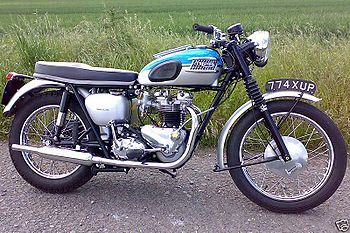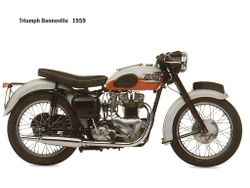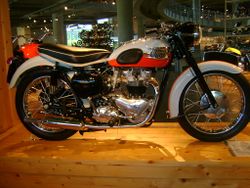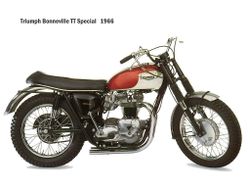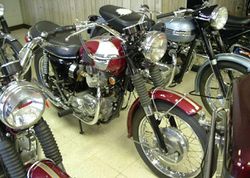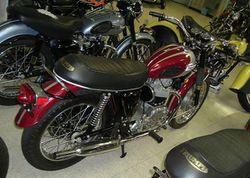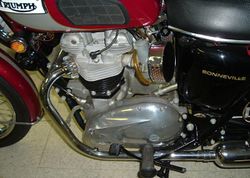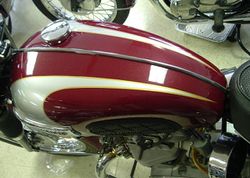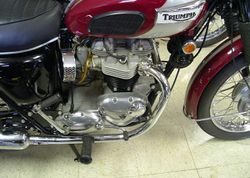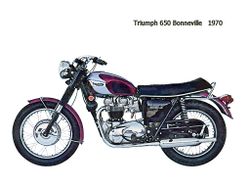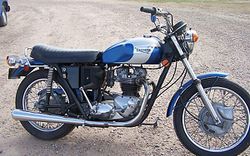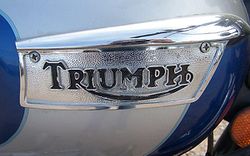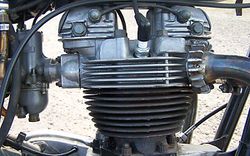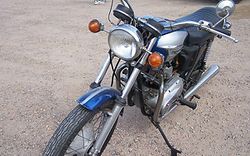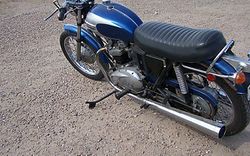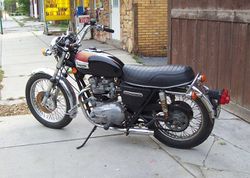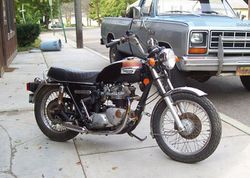Triumph Bonneville: history, specs, pictures
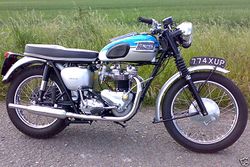 |
|
| Triumph Bonneville | |
| Manufacturer | |
|---|---|
| Production | 01-07 |
| Engine | 800cc |
| Spark Plug | NGK DPR8EA-9 '01-06 , '07 |
| Battery | YUASA YTX12-BS '01-06 , '07 |
| Final Drive | Chain: 525 `01-06[1] |
| Front Tire | 100/90-19 '07 100/90-17 '01-06 |
| Rear Tire | 130/80-17 '01-06 , '07 |
| Weight | |
| Manuals | Service Manual |
The Triumph Bonneville is a motorcycle produced by Triumph from 2001 to 2007.
Triumph Bonneville is the name given to three separate motorcycle models from this notable British motorcycle marque. It is named after the Bonneville Salt Flats in the state of Utah, USA, where Triumph and other motorcycle companies made attempts on the world motorcycle speed records. All share a parallel-twin four stroke engine configuration. The current version, produced since 2001 by the modern successor of the original company, is a completely redesigned and re-engineered evolution of the original design.
Since the arrival of the current 'Hinckley Bonneville' (produced in Hinckley, England), the earlier T120 and T140 (produced in Meriden, England) have been referred to as 'Meriden, West Midlands|Meriden Bonnevilles', to more easily distinguish between the versions.
Development History[edit | edit source]
The original Triumph Bonneville was popular (particularly in its early years) for its performance compared to other available bikes. Although its motor was later enlarged to 750 cc, in the late 1970s and early 1980s sales greatly suffered in competition with more modern and reliable Japanese motorbikes from Honda and other manufacturers.
Many enthusiasts argue that the Bonneville's manufactured between 1968 and 1970 represent the machine at its peak. The decision to employ components common to both the BSA and Triumph range was only just starting to have an impact and at this stage could be argued to have been of benefit, the nightmare that would emerge from Umberslade Hall as the ultimate expression of the "shared component" policy in the form of the P39 oil in frame was still three years away, in the meantime development of the Bonneville continued to be carried out at Meriden. The 1968 machines saw the introduction of an excellent new, twin leading shoe front brake which eradicated one of the remaining areas of criticism for the Bonneville and was arguably the most successful product of the "shared component" policy. The new brake was housed in a new set of forks which benefited from two way damping, offering a considerable improvement in performance in comparison to the items previously employed and, together with a slightly longer swinging arm further reinforced the Bonneville's claim to be one of the best handling machines in the world. The handling was backed up by a genuine 115 mph top speed, confirmed by road tests carried out on both sides of the "pond", placing the model firmly at the top of the performance chart, although the slightly "edgy" power delivery, resolved for the following season by the adoption of heavier flywheels, did not meet with every ones approval.
The Bonneville, originally introduced in 1959, benefited from a process of ongoing development throughout its production life which saw both major changes such as the introduction of unit construction (1963), new frame designs (1960 and 1963 being the most significant) and the adoption of twelve volt electrics for the 1966 season together with less obvious refinements. The 1967 machines were the first to adopt UNF threads in their construction, although at this stage they were confined to gearbox sub frame and petrol tank mountings. Other areas that received attention included the ignition system with revised points assemblies being specified and during the year Amal Concentric carburettors replaced the Monobloc items previously employed. Differences existed between the US and UK market machines, the former being fitted with stainless mudguards as opposed to painted ones employed for the home market, pancake airfilters were fitted to US market machines and the tank top parcel grid was deleted for the US. The Bonneville was offered with an aubergine over white petrol tank complimented by aubergine mudguards with a white stripe for the UK market, whilst, initially, the US models featured aubergine and gold petrol tanks. Unfortunately the gold paint employed degraded rapidly in the California sun and was quickly replaced by a white finish.
1959 Bonneville[edit | edit source]
Recognizable by the headlamp nacelle, generator, and remote fuel float bowl, these components were only featured on this year model. The Bonneville got its name due to the success of a team from Big D cycles in Dallas, Texas, that set a World Speed Record at the Bonneville Salt Flats in Utah with a Triumph powered streamliner.
1966 Bonneville TT Special[edit | edit source]
1970 Bonneville 650[edit | edit source]
1971 Bonneville 650[edit | edit source]
from a member - The page with the 1971 Triumph Bonneville pictures are mis-labeled. The bike shown is a Triumph Tiger 650. The bike could be a Trophy 650, but they were sold with high exhaust pipes on left side of bike and had other minor differences. Bonnevilles had twin carbs and were sold with gold and white paint.
another member - This is listed as a Triumph Bonneville. However, it only has one carb, so it cannot be a Bonneville. It might be a Trophy.
1978 Bonneville[edit | edit source]
Videos[edit | edit source]
References[edit | edit source]
- ↑ 2019 Western Power Sports Catalog. Western Power Sports. 2019.
| |||||||||||
In Media[edit | edit source]
- Si j'étais un homme
- Good Morning
- Young & Hungry
- Once Upon a Time in Venice
- Dans la brume
- Hannibal
- Grey's Anatomy
- Sonda
- Vanishing Point
- Melrose Place
- Up the Creek
- Star Stories
- L'amore è eterno finché dura
- Profilage
- Melrose Place
- Amore 14
- Brocéliande
- Scream and Scream Again
- Beach Blanket Bingo
- Ke$ha: Take It Off
- Lilly Schönauer - Umweg ins Glück
- Les Secrets
- I Dream of Jeannie
- The Walking Dead
- Killer Elite
- Reverb
- Dora Heldt: Kein Wort zu Papa
- Don 2
- La délicatesse
- Burlesque
- Liebe durch die Autotür
- Léo Matteï, Brigade des Mineurs
- Outrageous Fortune
- Alex Hugo
- Rixton: Me and My Broken Heart
- Ma vie au grand air
- Un flic
- The Lonely Island: We Need Love
- Avis de mistral
- Transporter: The Series
- Le sang de la vigne
- Devil May Cry
- Clem
- Disparue
- Policías, en el corazón de la calle
- Alex Santana, négociateur
- Kelsea Ballerini: Peter Pan
- Code Black
- Phoenixsee
- How to Make Love Like an Englishman
- Alice et Charlie
- Snatch
- I Cesaroni
- Hawaii Five-0
- Natale a Londra - Dio salvi la Regina
- Laurel Canyon
- Bad Blood
- Capitan Basilico
- La parrucchiera
- Alice's Restaurant
- Story of the Triumph Bonneville
- Angel Unchained
- Satan's Sadists
- Death in Paradise
- Harry Potter and the Sorcerer's Stone
- Behemoth, the Sea Monster
- The Saint
- The Baron
- The Damned
- Mechanic: Resurrection
- Jay Leno's Garage
- Fire in the Sky
- The Ambushers
- Svezia, inferno e paradiso
- Agathe Koltès
- Tout peut arriver
- If....
- Once Were Warriors
- The Way it Was
- Psychomania
- The Rookies
- Harley-Davidson: The American Motorcycle
- Lo strano vizio della Signora Wardh
- Dragon: The Bruce Lee Story
- The Driver
- The Black Six
- Envoyés très spéciaux
- The Good Wife
- Crush
- Auf Wiedersehen, Pet
- Night of the Comet
- Buffy the Vampire Slayer
- Looking for Alibrandi
- En by i provinsen
- The Late Shift
- The Rescue
- Ocean's Eight
- Race with the Devil
- Survivors
- Tsatsiki, morsan och polisen
- Tuck Everlasting
- How to Lose a Guy in 10 Days
- CSI: Crime Scene Investigation
- Rush
- Primeval
- The Mistress of Spices
- Yo quisiera
- Mission: Impossible III
- Week-end chez les Toquées
- Winners & Losers
- Wonderland
- Rat mal, wer zur Hochzeit kommt
- Triumph motorcycles
- 1950s motorcycles
- 1960s motorcycles
- 1970s motorcycles
- 650cc displacement motorcycles
- 650cc Twin cylinder motorcycles
- 650cc 4-stroke motorcycles
- Street motorcycles
- Twin cylinder motorcycles
- Twin cylinder 4-stroke motorcycles
- 4-stroke motorcycles
- Classic motorcycles
- 2000s motorcycles
- 2010s motorcycles
- 1980s motorcycles
- 1990s motorcycles
